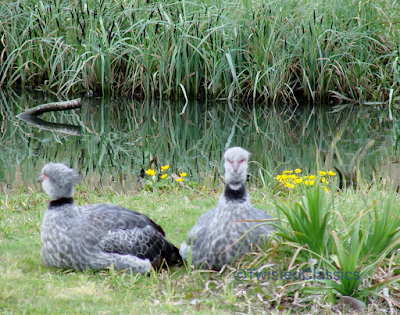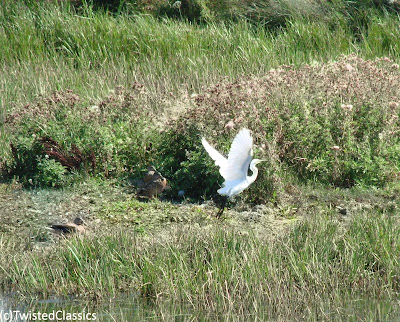Whenever I have the time, I love taking my camera for a walk in the park. There are several to choose from in London and, sometimes, I have great difficulty deciding between them. Battersea and St. James's are the nearest and I can easily walk to eithe , followed by Hyde Park, with Regent's Park being slightly further away - but both of these are easily reached by underground or bus. I never visit Green Park as there is no lake and I just love looking at all the water birds, so there is no point in going there.
This time, towards the end of August, I chose to walk round the lake in Hyde Park and Kensington Gardens. I went by underground to Hyde Park Corner and went into the park at the nearest entrance from the station, strolling through the flower garden, past the Dell and up to the lake. I began my walk along the Serpentine after passing the cafe that is at the end of the water.
The first interesting water bird I saw was a sweet and strange looking goose. I believe that it is a hybrid Canada/Greylag-mix. I think that it has a gorgeous face.
Then I came across a young Egyptian goose, which was swimming very quickly near the edge of the lake.
Following this, I saw a female Tufted duck with a duckling. Unfortunately, they refused to pose nicely together so I had to take separate photographs of them.
Here is mum:
and here is the baby:
The Serpentine is a boating lake and is often covered with Pedalos. There were plenty being used on it when I was there. The strange-looking building at the end of the lake is the cafe where I started my walk. The Shard can be seen in the distance, along with tall office buildings, reminding me that I was in London and not in the country!
There is another cafe in the park, by the swimming Lido, and here I found a cross-looking heron being stared at by a Canada goose.
The two lakes, Serpentine and Long Water, are dived by a road/pedestrian bridge. Now the lake is reserved just for wildlife and no Pedalos are allowed along it. It is very peaceful on the lake and there are not many places where the water can actually be seen as trees, shrubs and reeds line most of the banks on either side of the Long Water. Below is the view across the lake from one of the few areas at the edge of the lake, where a couple of swans form a tranquil country scene in front of a willow and some wild flowers.
After that, I came across a tree-lined path where tourists are always to be seen feeding, or attempting to feed, the green Ringed-necked Parakeets. Here three of them are deciding whether whatever is being offered is worth a flight.
At the next open area along the Long Water, there are some posts. Here I came across a couple of Egyptian geese doing a balancing act.
Also, there was a speckled Black-headed gull swimming backwards and forwards - hoping for someone to offer it something that was worth eating, though I think the birds in the park will eat almost anything that they can find.
On the other side of the Long Water, I came across a Magpie hopping around in the grass. I think, it too, was waiting for someone to feed it.
Back past the bridge and near the little island that is on this side of the Serpentine, I came found a parent Great Crested Grebe with two chicks. A Canada Goose is standing in the water near the island and giving them a once over with its beady eye.
They swam away from the goose and a third chick joined the group. I love their stripey heads and fluffy little bodies.
Standing on the island was a Heron and a Greylag goose, which was having a great preening session.
At the other end of the island, a Cormorant was standing on a post, drying its wings.
Another Cormorant was nearby wetting its wings and having a great bath!
Back out in the open water of the Serpentine there was a lonely large Mute cygnet, now looking very grown up. By now (this photograph was taken in August), I expect it will be able to fly.
And lastly, here is a photograph of the back of a cross Mute swan that was angrily chasing some other water bird.
On this trip to Hyde Park I had taken 140 pictures and this is just a selection of them. Even though it was over a month ago, I just have not had time until today to go through them. Instead, in my spare time, I have taken my camera for other walks - so have even more photographs to try and sort out!

























































